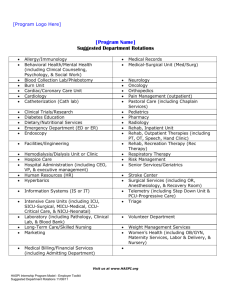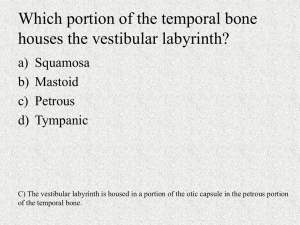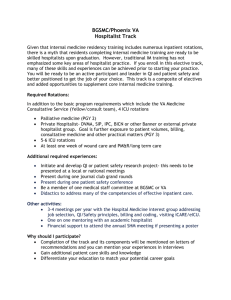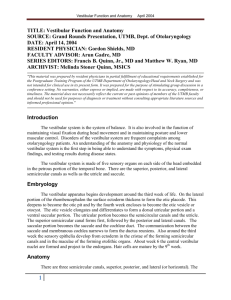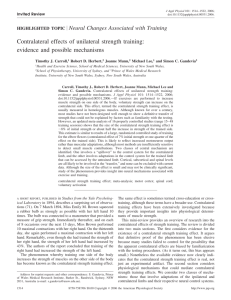Study Guides/Part_5
advertisement
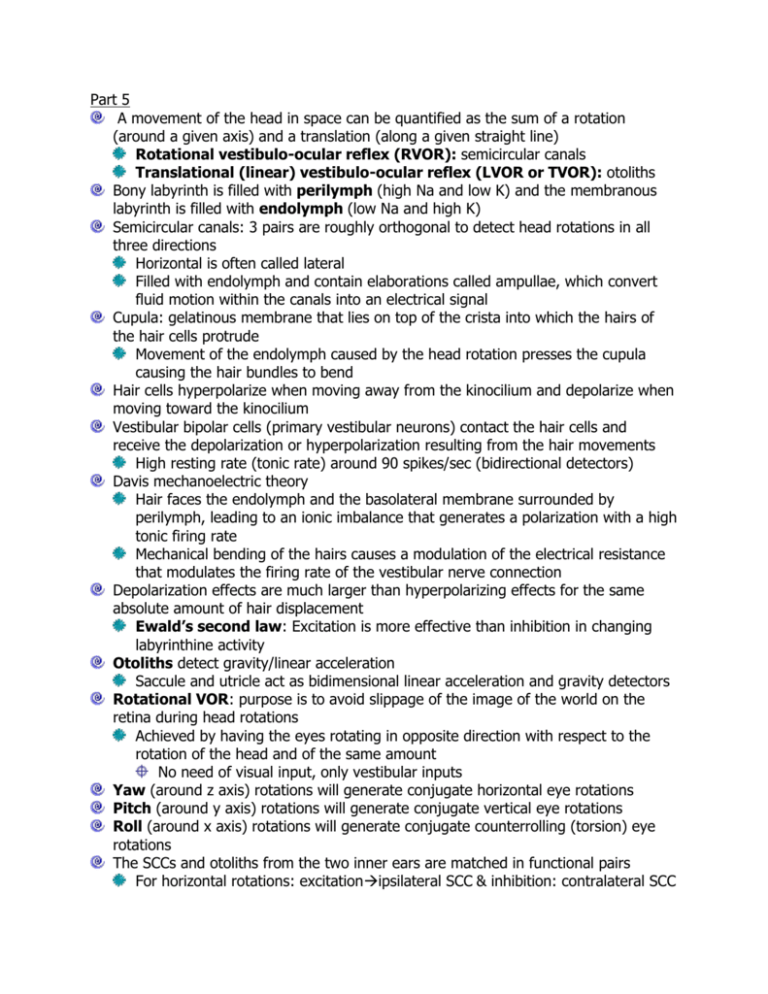
Part 5 A movement of the head in space can be quantified as the sum of a rotation (around a given axis) and a translation (along a given straight line) Rotational vestibulo-ocular reflex (RVOR): semicircular canals Translational (linear) vestibulo-ocular reflex (LVOR or TVOR): otoliths Bony labyrinth is filled with perilymph (high Na and low K) and the membranous labyrinth is filled with endolymph (low Na and high K) Semicircular canals: 3 pairs are roughly orthogonal to detect head rotations in all three directions Horizontal is often called lateral Filled with endolymph and contain elaborations called ampullae, which convert fluid motion within the canals into an electrical signal Cupula: gelatinous membrane that lies on top of the crista into which the hairs of the hair cells protrude Movement of the endolymph caused by the head rotation presses the cupula causing the hair bundles to bend Hair cells hyperpolarize when moving away from the kinocilium and depolarize when moving toward the kinocilium Vestibular bipolar cells (primary vestibular neurons) contact the hair cells and receive the depolarization or hyperpolarization resulting from the hair movements High resting rate (tonic rate) around 90 spikes/sec (bidirectional detectors) Davis mechanoelectric theory Hair faces the endolymph and the basolateral membrane surrounded by perilymph, leading to an ionic imbalance that generates a polarization with a high tonic firing rate Mechanical bending of the hairs causes a modulation of the electrical resistance that modulates the firing rate of the vestibular nerve connection Depolarization effects are much larger than hyperpolarizing effects for the same absolute amount of hair displacement Ewald’s second law: Excitation is more effective than inhibition in changing labyrinthine activity Otoliths detect gravity/linear acceleration Saccule and utricle act as bidimensional linear acceleration and gravity detectors Rotational VOR: purpose is to avoid slippage of the image of the world on the retina during head rotations Achieved by having the eyes rotating in opposite direction with respect to the rotation of the head and of the same amount No need of visual input, only vestibular inputs Yaw (around z axis) rotations will generate conjugate horizontal eye rotations Pitch (around y axis) rotations will generate conjugate vertical eye rotations Roll (around x axis) rotations will generate conjugate counterrolling (torsion) eye rotations The SCCs and otoliths from the two inner ears are matched in functional pairs For horizontal rotations: excitationipsilateral SCC & inhibition: contralateral SCC An increase in activity in one anterior canal will cause a decrease in activity in the contralateral posterior canal and vice versa During vertical and counterrolling rotations all four A/P SCCs are active Anterior canal: excited by downward head motion Excites: ipsilateral SR and contralateral IO Inhibits: ipsilateral IR and contralateral SO Posterior canal: excited by upward head motion Excites: contralateral IR and ipsilateral SO Inhibits: contralateral SR and ipsilateral IO For the otoliths, the saccule and utricle outputs are also organized in a ipsi/contra push-pull circuitry Allows the almost full recovery from the complete loss of one inner ear after a period of adaptation (rebalance) of the signals during the acute phase, when strong nystagmus occurs Three-neurons arc: the direct path from the hair cells to the EOM is a short 3neurons arc, which maximizes the response speed Primary vestibular neurons (Scarpa’s ganglions)-have dendrites connected with the hair cells and synapse on the secondary vestibular neurons Secondary vestibular neurons in the vestibular nuclei Motorneurons in the oculomotor complex, directly or indirectly projecting to the EOMs
